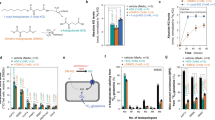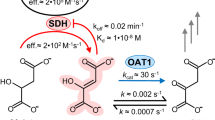Abstract
Metabolic enzymes are very specific. However, most of them show weak side activities toward compounds that are structurally related to their physiological substrates, thereby producing side products that may be toxic. In some cases, 'metabolite repair enzymes' eliminating side products have been identified. We show that mammalian glyceraldehyde 3-phosphate dehydrogenase and pyruvate kinase, two core glycolytic enzymes, produce 4-phosphoerythronate and 2-phospho-L-lactate, respectively. 4-Phosphoerythronate strongly inhibits an enzyme of the pentose phosphate pathway, whereas 2-phospho-L-lactate inhibits the enzyme producing the glycolytic activator fructose 2,6-bisphosphate. We discovered that a single, widely conserved enzyme, known as phosphoglycolate phosphatase (PGP) in mammals, dephosphorylates both 4-phosphoerythronate and 2-phospho-L-lactate, thereby preventing a block in the pentose phosphate pathway and glycolysis. Its yeast ortholog, Pho13, similarly dephosphorylates 4-phosphoerythronate and 2-phosphoglycolate, a side product of pyruvate kinase. Our work illustrates how metabolite repair enzymes can make up for the limited specificity of metabolic enzymes and permit high flux in central metabolic pathways.
This is a preview of subscription content, access via your institution
Access options
Subscribe to this journal
Receive 12 print issues and online access
$259.00 per year
only $21.58 per issue
Buy this article
- Purchase on Springer Link
- Instant access to full article PDF
Prices may be subject to local taxes which are calculated during checkout






Similar content being viewed by others
Accession codes
Accessions
NCBI Reference Sequence
References
Tawfik, D.S. Accuracy-rate tradeoffs: how do enzymes meet demands of selectivity and catalytic efficiency? Curr. Opin. Chem. Biol. 21, 73–80 (2014).
Linster, C.L., Van Schaftingen, E. & Hanson, A.D. Metabolite damage and its repair or pre-emption. Nat. Chem. Biol. 9, 72–80 (2013).
Bauwe, H., Hagemann, M. & Fernie, A.R. Photorespiration: players, partners and origin. Trends Plant Sci. 15, 330–336 (2010).
Notebaart, R.A. et al. Network-level architecture and the evolutionary potential of underground metabolism. Proc. Natl. Acad. Sci. USA 111, 11762–11767 (2014).
Tawfik, D.S. Messy biology and the origins of evolutionary innovations. Nat. Chem. Biol. 6, 692–696 (2010).
Rzem, R. et al. A mouse model of L-2-hydroxyglutaric aciduria, a disorder of metabolite repair. PLoS ONE 10, e0119540 (2015).
Van Schaftingen, E. et al. Metabolite proofreading, a neglected aspect of intermediary metabolism. J. Inherit. Metab. Dis. 36, 427–434 (2013).
Bracher, A., Sharma, A., Starling-Windhof, A., Hartl, F.U. & Hayer-Hartl, M. Degradation of a potent Rubisco inhibitor by selective sugar phosphatase. Nat. Plants 1, 14002 (2015).
Wiśniewski, J.R., Hein, M.Y., Cox, J. & Mann, M.A. 'Proteomic ruler' for protein copy number and concentration estimation without spike-in standards. Mol. Cell. Proteomics 13, 3497–3506 (2014).
Ishii, Y., Hashimoto, T., Minakami, S. & Yoshikawa, H. The formation of erythronic acid 4-phosphate from erythrose 4-phosphate by glyceraldehyde-3-phosphate dehydrogenase. J. Biochem. 56, 111–112 (1964)<>.
Pasti, C. et al. Sugar derivatives as new 6-phosphogluconate dehydrogenase inhibitors selective for the parasite Trypanosoma brucei. Bioorg. Med. Chem. 11, 1207–1214 (2003).
Maliekal, P., Vertommen, D., Delpierre, G. & Van Schaftingen, E. Identification of the sequence encoding N-acetylneuraminate-9-phosphate phosphatase. Glycobiology 16, 165–172 (2006).
Ndubuisil, M.I. et al. Characterization of a novel mammalian phosphatase having sequence similarity to Schizosaccharomyces pombe PHO2 and Saccharomyces cerevisiae PHO13. Biochemistry 41, 7841–7848 (2002).
Rose, Z.B., Grove, D.S. & Seal, S.N. Mechanism of activation by anions of phosphoglycolate phosphatases from spinach and human red blood cells. J. Biol. Chem. 261, 10996–11002 (1986).
Ran, F.A. et al. Genome engineering using the CRISPR-Cas9 system. Nat. Protoc. 8, 2281–2308 (2013).
Fan, J. et al. Quantitative flux analysis reveals folate-dependent NADPH production. Nature 510, 298–302 (2014).
Schöneberg, T., Kloos, M., Bruser, A., Kirchberger, J. & Strater, N. Structure and allosteric regulation of eukaryotic 6-phosphofructokinases. Biol. Chem. 394, 977–993 (2013).
Rider, M.H. et al. 6-phosphofructo-2-kinase/fructose-2,6-bisphosphatase: head-to-head with a bifunctional enzyme that controls glycolysis. Biochem. J. 381, 561–579 (2004).
Van Schaftingen, E., Hue, L. & Hers, H.G. Fructose 2,6-bisphosphate, the probable structure of the glucose- and glucagon-sensitive stimulator of phosphofructokinase. Biochem. J. 192, 897–901 (1980).
Ash, D.E., Goodhart, P.J. & Reed, G.H. ATP-dependent phosphorylation of α-substituted carboxylic acids catalyzed by pyruvate kinase. Arch. Biochem. Biophys. 228, 31–40 (1984).
Kim, S.R. et al. Deletion of PHO13, encoding haloacid dehalogenase type IIA phosphatase, results in upregulation of the pentose phosphate pathway in Saccharomyces cerevisiae. Appl. Environ. Microbiol. 81, 1601–1609 (2015).
Leblond, D.J. & Robinson, J.L. Secondary kinase reactions catalyzed by yeast pyruvate kinase. Biochim. Biophys. Acta 438, 108–118 (1976).
Schwarte, S. & Bauwe, H. Identification of the photorespiratory 2-phosphoglycolate phosphatase, PGLP1, in Arabidopsis. Plant Physiol. 144, 1580–1586 (2007).
Kaneko, Y., Toh-e, A., Banno, I. & Oshima, Y. Molecular characterization of a specific p-nitrophenylphosphatase gene, PHO13, and its mapping by chromosome fragmentation in Saccharomyces cerevisiae. Mol. Gen. Genet. 220, 133–139 (1989).
Seifried, A. et al. Evolutionary and structural analyses of mammalian haloacid dehalogenase-type phosphatases AUM and chronophin provide insight into the basis of their different substrate specificities. J. Biol. Chem. 289, 3416–3431 (2014).
Corbier, C., Della Seta, F. & Branlant, G. A new chemical mechanism catalyzed by a mutated aldehyde dehydrogenase. Biochemistry 31, 12532–12535 (1992).
Stefani, M., Taddei, N. & Ramponi, G. Insights into acylphosphatase structure and catalytic mechanism. Cell. Mol. Life Sci. 53, 141–151 (1997).
Dixon, H.B.F. The biochemical action of arsonic acids especially as phosphate analogues. Adv. Inorg. Chem. 44, 191–227 (1996).
Fiehn, O., Barupal, D.K. & Kind, T. Extending biochemical databases by metabolomic surveys. J. Biol. Chem. 286, 23637–23643 (2011).
Stincone, A. et al. The return of metabolism: biochemistry and physiology of the pentose phosphate pathway. Biol. Rev. Camb. Philos. Soc. 90, 927–963 (2014).
Delcenserie, V. et al. Description of a new species, Bifidobacterium crudilactis sp. nov., isolated from raw milk and raw milk cheeses. Syst. Appl. Microbiol. 30, 381–389 (2007).
Boschi-Muller, S., Azza, S., Pollastro, D., Corbier, C. & Branlant, G. Comparative enzymatic properties of GapB-encoded erythrose-4-phosphate dehydrogenase of Escherichia coli and phosphorylating glyceraldehyde-3-phosphate dehydrogenase. J. Biol. Chem. 272, 15106–15112 (1997).
Itaya, K. & Ui, M. A new micromethod for the colorimetric determination of inorganic phosphate. Clin. Chim. Acta 14, 361–366 (1966).
Nowak, T. & Mildvan, A.S. Stereoselective interactions of phosphoenolpyruvate analogues with phosphoenolpyruvate-utilizing enzymes. J. Biol. Chem. 245, 6057–6064 (1970).
Delpierre, G. et al. Identification, cloning, and heterologous expression of a mammalian fructosamine-3-kinase. Diabetes 49, 1627–1634 (2000).
Collard, F. et al. Molecular identification of N-acetylaspartylglutamate synthase and β-citrylglutamate synthase. J. Biol. Chem. 285, 29826–29833 (2010).
Kitagawa, M. et al. Complete set of ORF clones of Escherichia coli ASKA library (a complete set of E. coli K-12 ORF archive): unique resources for biological research. DNA Res. 12, 291–299 (2005).
Manzano, A. et al. Cloning, expression and chromosomal localization of a human testis 6-phosphofructo-2-kinase/fructose-2,6-bisphosphatase gene. Gene 229, 83–89 (1999).
Deprez, J., Vertommen, D., Alessi, D.R., Hue, L. & Rider, M.H. Phosphorylation and activation of heart 6-phosphofructo-2-kinase by protein kinase B and other protein kinases of the insulin signaling cascades. J. Biol. Chem. 272, 17269–17275 (1997).
Novellasdemunt, L. et al. PFKFB3 activation in cancer cells by the p38/MK2 pathway in response to stress stimuli. Biochem. J. 452, 531–543 (2013).
Van Schaftingen, E., Lederer, B., Bartrons, R. & Hers, H.G. A kinetic study of pyrophosphate: fructose-6-phosphate phosphotransferase from potato tubers. Application to a microassay of fructose 2,6-bisphosphate. Eur. J. Biochem. 129, 191–195 (1982).
Brachmann, C.B. et al. Designer deletion strains derived from Saccharomyces cerevisiae S288C: a useful set of strains and plasmids for PCR-mediated gene disruption and other applications. Yeast 14, 115–132 (1998).
Güldener, U., Heck, S., Fielder, T., Beinhauer, J. & Hegemann, J.H. A new efficient gene disruption cassette for repeated use in budding yeast. Nucleic Acids Res. 24, 2519–2524 (1996).
Amberg, D., Burke, D. & Straethern, J. Methods in Yeast Genetics (CSHL Press, 2005).
de Koning, W. & van Dam, K. A method for the determination of changes of glycolytic metabolites in yeast on a subsecond time scale using extraction at neutral pH. Anal. Biochem. 204, 118–123 (1992).
Metallo, C.M. et al. Reductive glutamine metabolism by IDH1 mediates lipogenesis under hypoxia. Nature 481, 380–384 (2012).
Jaeger, C. et al. The mouse brain metabolome: region-specific signatures and response to excitotoxic neuronal injury. Am. J. Pathol. 185, 1699–1712 (2015).
Feijó Delgado, F. et al. Intracellular water exchange for measuring the dry mass, water mass and changes in chemical composition of living cells. PLoS ONE 8, e67590 (2013).
Millard, P., Letisse, F., Sokol, S. & Portais, J.C. IsoCor: correcting MS data in isotope labeling experiments. Bioinformatics 28, 1294–1296 (2012).
Gerin, I. et al. Identification of TP53-induced glycolysis and apoptosis regulator (TIGAR) as the phosphoglycolate-independent 2,3-bisphosphoglycerate phosphatase. Biochem. J. 458, 439–448 (2014).
O'Brien, J., Wilson, I., Orton, T. & Pognan, F. Investigation of the Alamar Blue (resazurin) fluorescent dye for the assessment of mammalian cell cytotoxicity. Eur. J. Biochem. 267, 5421–5426 (2000).
Zhu, C.T. & Rand, D.M. A hydrazine coupled cycling assay validates the decrease in redox ratio under starvation in Drosophila. PLoS ONE 7, e47584 (2012).
Acknowledgements
Funding was provided from WELBIO (CR-2015A-09 to E.V.S.), the Belgian National Science Fund (T.0120.14 to E.V.S. and J.0044.14 to G.T.B.), the Training Fund for Research in Industry and Agriculture (to F.B. and J.B.), the Belgian Cancer Foundation (2010-155 to G.T.B. and 2014-298 to E.V.S.), the Interuniversity Attraction Pole (IAP-P7.43 to E.V.S.), the European Union Seventh Framework Programme (FP7/2007–2013 grant no. 276814 to C.L.L. and EURO-CDG to E.V.S.) and Horizon 2020 (E-RARE-3: EURO-CDG2 to E.V.S.), the de Duve Institute and the Université Catholique de Louvain. We would like to thank E.R. Fearon (University of Michigan), F. Zhang (Massachusetts Institute of Technology), V. Delcenserie (University of Liège), G. Daube (University of Liège), L. Novellasdemunt and R. Bartrons (University of Barcelona) for reagents, R. Gemayel (Catholic University of Leuven) for help with yeast experiments, C. Jäger and C. Singh (University of Luxembourg) for help with the GC/MS analysis, P. Sonveaux (Université Catholique de Louvain) and P.E. Porporato (Université Catholique de Louvain) for help with the Seahorse XF bioanalyzer (grant F.R.S.-FNRS FRFC 2.5025.12) and A.D. Hanson, L. Hue, J.-F. Collet and A. Peracchi for critical reading of the manuscript.
Author information
Authors and Affiliations
Contributions
The study was mainly designed and written by G.T.B., E.V.S., F.C. and F.B. G.T.B. and E.V.S. supervised the work and are equally contributing corresponding authors. All authors contributed to the interpretation of the results, participated in the writing of the manuscript and approved the final version. F.C. identified and purified PGP and ACYP1. F.C., F.B. and I.G. performed enzymatic analysis. F.B., I.G., G.T.B., J.G. and C.L.L. performed GC/MS analysis. G.T.B., I.G., J.B., M.V. and F.B. generated and analyzed mammalian cell lines. J.B. measured oxygen consumption rate. F.B. generated and analyzed yeast strains. G.N., E.V.S. and I.G. performed PFK-2 analysis. A.H. and M.H.R. cloned and produced PFKFB proteins. D.V. and V.S. performed MS analysis.
Corresponding authors
Ethics declarations
Competing interests
The authors declare no competing financial interests.
Supplementary information
Supplementary Text and Figures
Supplementary Results, Supplementary Figures 1–15 and Supplementary Tables 1–3. (PDF 3394 kb)
Supplementary Data Set 1
Raw GC-MS data (XLSX 108 kb)
Supplementary Data Set 2
Raw GC-MS data (XLSX 157 kb)
Rights and permissions
About this article
Cite this article
Collard, F., Baldin, F., Gerin, I. et al. A conserved phosphatase destroys toxic glycolytic side products in mammals and yeast. Nat Chem Biol 12, 601–607 (2016). https://doi.org/10.1038/nchembio.2104
Received:
Accepted:
Published:
Issue Date:
DOI: https://doi.org/10.1038/nchembio.2104
This article is cited by
-
High-throughput Saccharomyces cerevisiae cultivation method for credentialing-based untargeted metabolomics
Analytical and Bioanalytical Chemistry (2023)
-
Glycolytic flux control by drugging phosphoglycolate phosphatase
Nature Communications (2022)
-
Phosphoglycolate phosphatase homologs act as glycerol-3-phosphate phosphatase to control stress and healthspan in C. elegans
Nature Communications (2022)
-
Chemical genomics with pyrvinium identifies C1orf115 as a regulator of drug efflux
Nature Chemical Biology (2022)
-
Human cytosolic transaminases: side activities and patterns of discrimination towards physiologically available alternative substrates
Cellular and Molecular Life Sciences (2022)



